See the 1970s P&G tampon
Trust and the later
notorious Rely. See
the other tampons
Procter & Gamble sold around the time of
Rely.
Read also the important following
articles (issues
listed) in the Rochester
(New York)
Patriot newspaper, which
investigated Rely in 1975 and 1976, years
before the toxic shock crisis: 23 July-5 August
1975 (front cover)
- 6-26 August
1975 - 11 December
1975-13 January 1976 - 1-14 September
1976) - a letter
to a customer assuring her that Rely was
safe (April 1980) - and a letter from
Procter & Gamble (22 September 1980)
announcing that it was stopping distribution
of Rely because of health concerns


|

Soft
Shape menstrual tampon
(Procter & Gamble, 1968,
U.S.A.)
Satan
worship, said
Fundamentalist groups
Procter & Gamble produced several
tampons before its big
mistake, Rely,
which stopped it in its tracks
until the company bought Tampax in
1997. Soft Shape was one of those
pre-Rely tampons.
Nothing on or in the box
explains the name of this tampon.
The plastic applicator is fairly
rigid and the cotton plug is,
well, cotton.
The box bears the infamous logo
(below) that caused
certain Christian groups to claim
that P&G was in league with
the devil and would
contribute a percentage of its
profits to the Church of Satan. As
far as I know the tampon itself
was innocent.
Here's what a proponent of this
story has to say (I added the
emphasis in red):
". . . Procter's
relationship to the devil
dates back decades. During the
1960's, Christians who looked
closely at the corporate logo,
a moon-star symbol that had
appeared on many of the
company's products since 1882
[see it
below], saw not 13
stars representing the 13
original colonies as the
company insisted, but
something altogether
different: the Mark of the
Beast. The
arrangement of stars, noted
these witnesses, secretly
spelled out the numbers
'666,' immediately
recognizable to students of
the Bible as the digits of
the devil.
"While Procter dropped its
satanic logo in 1985,
there's no word yet on what
logo the merged companies will
use, and whether the new image
will incorporate the mark of
the beast. Analysts note that
in recent years, Procter has
worked to update what has long
been a staid image, and is
thus unlikely to reuse the
satanic logo from its past."
[From
http://swiftreport.blogs.com/news/2005/02/christian_group.html
February 01, 2005, "Christian
Groups Move to Block Procter
& Gamble Merger"]
As you might imagine, there
was more to the story. A Time
magazine story ("Procter &
Gamble Fights Back") from 19
July 1982 stated,
"One day around the year
1851, a Cincinnati wharf hand
painted black crosses on boxes
of Procter & Gamble
candles so that illiterate
workers could distinguish
them. In time the cross became
a star. Then a dozen more
stars were added to signify
the original 13 colonies, as
well as a quarter moon with a
human face, a popular image of
the time. By 1882 the unusual
logo had become Procter &
Gamble's trademark. . . .
"Lately, however, it has
become a major corporate
problem because of a virulent
whispering campaign alleging
that the logo is satanic and
that Procter & Gamble is
somehow involved in the
worship of the devil. The talk
first surfaced in January
1980, and reappeared two years
later when the firm began
getting thousands of phone
calls about stories that company
officials had confessed on
the Phil Donahue and Merv
Griffin television shows
that Procter & Gamble
and its top executives were
supporting devil worship.
There were never any such
programs." [From
http://www.time.com/time/magazine/article/0,9171,953563,00.html
]
Read much more at the links.
It's a fascinating piece of
Americana that, um, resonates
today.
|
Below:
The cardboard box measures 3 x 5.5
x 1 1/4" (8 x 14.3 x 3 cm). Both sides have
the same colors but I
wasn't able to make them match.
The color of the side below is
truer than the one at right.
|
Below:
Other side of the box. The ARROWS
point to features
enlarged below.
|
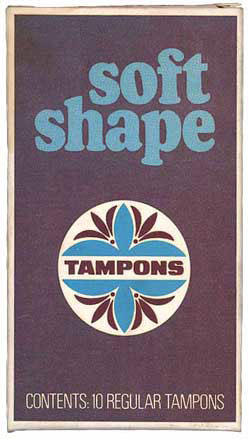 |
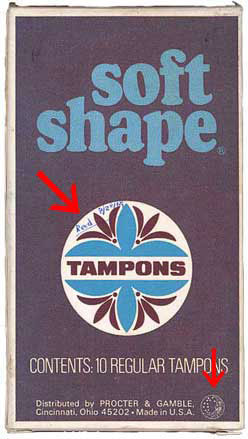 |
Below:
See the LARGE
ARROW, above right.
Somebody at the former Tambrands,
which made Tampax, wrote on the
box, which I take to mean received [at
Tambrands] 28 August 1969.
|
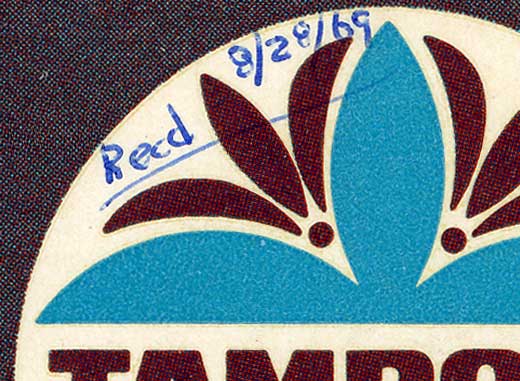 |
Below:
See the SMALL
ARROW, right-hand box.
This is the logo many American
Fundamentalist Christian groups
said represented P&G's
connection to devil worship. Read
some explanation
above. Can you see 666 in
the stars? I can't.
|
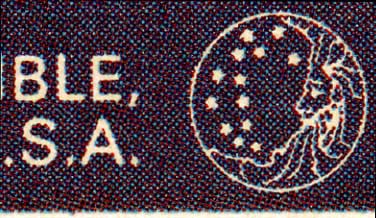 |
Below:
The small sides are blank.
|
Below:
The ends are identical except for
the 2/49
below - two boxes for 49 cents?
But that seems too low.
|
 |
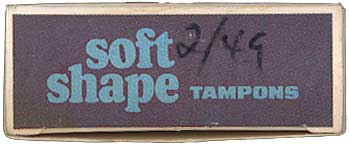 |
NEXT: Tampons
& instructions
See the 1970s P&G tampon Trust and the later
notorious Rely. See
the other tampons
Procter & Gamble
sold around the time of Rely.
All tampons, pads, belts, bidets, miscellaneous, puberty booklets,
art, underpants, teen ads
MORE in column at left.
© 2008 Harry Finley. It is illegal to
reproduce
or distribute work on this Web site in any
manner or
medium without written permission of the
author.
Please report suspected violations to hfinley@mum.org
|